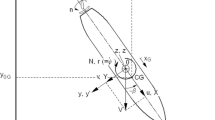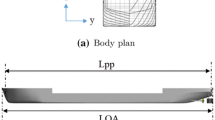Abstract
To assess the navigability of deep drafted vessels in muddy navigation areas a mathematical model has been built that takes into account the characteristics of the mud layer. This was achieved with the introduction of a fluidization parameter which determines the corresponding hydrodynamically equivalent depth above a solid bottom. As a result, the under keel clearance dependency of a given mathematical manoeuvring model can be reformulated in such way that the effect of any realistic muddy condition is included. In this article the modelling of the propeller and rudder induced forces and the implementation possibilities of the model will be discussed. It is concluded that the mathematical model, initially formulated for a 6,000 TEU container carrier, provides reliable predictions of the behaviour of larger container carriers and even fuller deep drafted ships.


















Similar content being viewed by others
Abbreviations
- “1”:
-
Layer thickness, Table 2 (–)
- “2”:
-
Layer thickness, Table 2 (–)
- “3”:
-
Layer thickness, Table 2 (–)
- AEP:
-
Expanded area ratio of propeller (–)
- a H :
-
Coefficient, Eq. 38 (–)
- a i :
-
Regression coefficient (i = 0, μ) (–)
- A R :
-
Rudder area (m²)
- B :
-
Ship beam (m)
- “b”:
-
Mud type, Table 2 (–)
- “c”:
-
Mud type, Table 2 (–)
- C B :
-
Block coefficient (–)
- D:
-
Derivative (–)
- “D”:
-
6,000 TEU container ship model, Table 1 (–)
- “d”:
-
Mud type, Table 2 (–)
- D P :
-
Propeller diameter (m)
- “E”:
-
Tanker model, Table 1 (–)
- “e”:
-
Mud type, Table 2 (–)
- F :
-
Force component (–)
- f :
-
Function or parameter (–)
- “f”:
-
Mud type, Table 2 (–)
- F n :
-
Froude number (based on L) (–)
- F X :
-
Longitudinal rudder force (N)
- F Y :
-
Lateral rudder force (N)
- “g”:
-
Mud type, Table 2 (–)
- h :
-
Depth/thickness (m)
- “h”:
-
Mud type, Table 2 (–)
- h*:
-
Hydrodynamically equivalent depth (m)
- J:
-
Advance (–)
- K i :
-
Quadrant selector (i = 1, 2) (–)
- L, L PP :
-
Ship length (m)
- m :
-
Ship mass (kg)
- N :
-
Yawing moment (Nm)
- n :
-
Propeller rate (1/s)
- n 0 :
-
Nominal propeller rate (=100 rpm) (1/s)
- N i :
-
Hydrodynamic derivative \( (i = \dot{v},\dot{r}, \ldots ) \) (–)
- P :
-
Propeller pitch (m)
- r :
-
Yaw rate (rad/s)
- r i :
-
Empirical yaw rate to classify oscillations, Eqs. 28 and 29 (i = os,max; is,max) (rad/s)
- \( \dot{r} \) :
-
Yaw acceleration (rad/s²)
- \( \dot{r}_{i} \) :
-
Empirical yaw acceleration to classify oscillations, Eqs. 28 and 29 (i = os,max; is,max) (rad/s²)
- “S”:
-
Solid bottom, Table 2 (–)
- T :
-
Ship draft (m)
- t :
-
Thrust deduction factor (–), time (s)
- \( t_{( \ldots)}^{( \ldots )} \) :
-
Regression coefficients for thrust deduction (–)
- TEU:
-
Twenty feet equivalent unit (–)
- T f :
-
Period of f (s)
- T P :
-
Propeller thrust (N)
- t R :
-
Deduction factor for XR (–)
- “U”:
-
8,000 TEU container ship model, Table 1 (–)
- u :
-
Longitudinal velocity (m/s)
- \( \dot{u} \) :
-
Longitudinal acceleration (m/s²)
- ukc:
-
Under keel clearance (referred to draft) (%)
- v :
-
Lateral velocity (m/s)
- \( \dot{v} \) :
-
Lateral acceleration (m/s²)
- X :
-
Longitudinal force (N)
- x H :
-
Application point of a H F Y (m)
- X i :
-
Hydrodynamic derivative \( (i = \dot{u}, \ldots ) \) (–)
- Y :
-
Sway force (N)
- Y i :
-
Hydrodynamic derivative \( (i = \dot{v},\dot{r}, \ldots ) \) (–)
- α:
-
Regression coefficient (–)
- β:
-
Drift angle (deg), regression coefficient (–)
- γ:
-
Yaw rate angle (deg)
- γ*:
-
Apparent hydrodynamic angle, Eq. 11 (deg)
- δ:
-
Rudder angle (deg)
- ε*:
-
Apparent hydrodynamic angle, Eq. 9 (deg)
- μ:
-
Dynamic viscosity (Pa s)
- μ′:
-
Non-dimensional dynamic viscosity, Eq. 18 (–)
- Π(T) :
-
Keel penetration parameter (–)
- ξ i :
-
Regression coefficient that takes, account of under keel clearance (i = 0, 1, ½, 2) (–)
- Φ:
-
Fluidization parameter (–)
- Φ ij :
-
Regression coefficient that takes account of mud characteristics (i = 0, h; j = 0, μ) (–)
- φ*:
-
Apparent hydrodynamic angle, Eq. 10 (–)
- ϕ:
-
Phase angle (deg)
- ω:
-
Frequency (rad/s)
- 1:
-
Water layer
- 2:
-
Mud layer
- A:
-
Amplitude
- BP:
-
Bollard pull
- ex:
-
Extrapolated
- H:
-
Hull
- P:
-
Propeller
- m:
-
Mean value
- R:
-
Rudder
- T:
-
Thrust
- 1:
-
First quadrant
- 2:
-
Second quadrant
- 3:
-
Third quadrant
- 4:
-
Fourth quadrant
- n :
-
Caused by propeller action
References
PIANC (1997) Approach channels—a guide for design. Final report of the joint Working Group PIANC and IAPH, in cooperation with IMPA and IALA. Supplement to PIANC Bulletin, No. 95
Delefortrie G, Vantorre M, Eloot K (2005) Modelling navigation in muddy areas through captive model tests. J Marine Sci Technol 10(4):188–202
Delefortrie G, Vantorre M, Verzhbitskaya E, et al (2007) Evaluation of safety of navigation in muddy areas through real time manoeuvring simulation. J Waterway Port Coastal Ocean Eng 133(2):125–135
Delefortrie G, Vantorre M (2007) Modeling the maneuvering behavior of container carriers in shallow water. J Ship Res 51(4):287–296
Delefortrie G, Vantorre M (2009) Prediction of the forces acting on container carriers in muddy navigation areas using a fluidization parameter. J Marine Sci Technol. doi:10.1007/s00773-009-0041-x
Eloot K (2006) Selection, experimental determination and evaluation of a mathematical model for ship manoeuvring in shallow water. Doctoral thesis, Ghent University, Faculty of Engineering
Vantorre M, Eloot K (1996) Hydrodynamic phenomena affecting manoeuvres at low speed in shallow water navigation areas. In: Proceedings of the 11th international harbour congress. The Royal Flemish Society of Engineers, Antwerp, pp 535–546
Brossard C, Delouis A, Galichon P, et al (1990) Navigability in channels subject to siltation. In: Proceedings of the 22nd international coastal engineering conference, Delft, The Netherlands, pp 3088–3101
Sellmeijer R, van Oortmerssen G (1983) The effect of mud on tanker manoeuvres. The Royal Institution of Naval Architects, Spring Meetings, paper no. 7
Vantorre M, Coen I (1988) On sinkage and trim of vessels navigating above a mud layer. The Royal Society of Flemish Engineers, Harbour Congress
Acknowledgments
The generalised mathematical model is based on experimental results obtained at Flanders Hydraulics Research (Antwerp, Belgium) and has been developed in the frame of research project “Validation of the Nautical Bottom Concept” by order of the Flemish Government (ref 16EB/0501), Belgium.
Author information
Authors and Affiliations
Corresponding author
About this article
Cite this article
Delefortrie, G., Vantorre, M. Modelling propeller and rudder induced forces acting on deep drafted vessels in muddy navigation areas. J Mar Sci Technol 14, 171–184 (2009). https://doi.org/10.1007/s00773-009-0045-6
Received:
Accepted:
Published:
Issue Date:
DOI: https://doi.org/10.1007/s00773-009-0045-6




